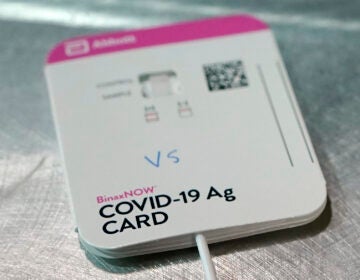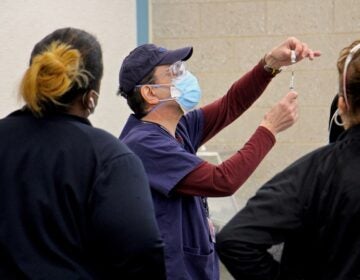How to get the most out of your virtual medical appointment

A patient consults their doctor via telemedicine.(Janice Chang/NPR)
I’m a primary care doctor, and, in normal times, my favorite part of the job is getting to see my patients regularly. But because of the ongoing COVID-19 pandemic, I’ve had to substantially cut down on in-person visits to help put the brakes on the spread of the coronavirus.
In this time of high medical anxiety, the phones at my clinic have, understandably, been ringing off the hook.
In addition to questions about symptoms that might signal COVID-19, my patients still need to know if the pain in their knee after a fall signals a broken bone or torn ligament that requires treatment; whether their child with a fever needs antibiotics; whether that sudden swelling in their ankles is a sign we should change their medication.
For many such cases, I once would have said, “Come on in, and let’s get you checked out.” But now we’re all pivoting to e-mail, phone calls, and video chats.
Here are some tips to help you know when to call your doctor and how to get the most out of your virtual visit:
If you don’t have a doctor yet, get one. Because of the pandemic, many primary care providers are allowing new patients to establish care via a telemedicine appointment. (Previously, many practices would only return the calls of patients who had already been seen in person at some point.) Your new doctor will probably ask you to come in for an in-person visit when it becomes safe to do so.
Many urgent care centers and walk-in clinics are also offering telemedicine visits; you can call or check out their website to set up an appointment.
Emergencies are still emergencies. Some of the same rules from pre-pandemic days apply: Sudden chest pain, weakness in one side of the face or body, or a sudden thunder-clap headache are all red-alert symptoms that could signal a heart attack or stroke. The same goes for serious difficulty breathing or sudden-onset confusion in a loved one. Call 911 pronto in these cases, to quickly get a trained professional to you who can evaluate you in-person.
Urgent, but not an emergency? Call your primary care provider’s office. Ask yourself if, in pre-pandemic times, these symptoms would have led you to call your doctor in the middle of the night for advice, or at least made you call for a same-day appointment the next morning. Common concerns in this category include high fevers, a new source of pain, or a minor injury. If the answer is yes, or if you aren’t sure, please give your doctor a call right away.
“If you feel as though this is a … situation that can’t wait, that would make you pick up and go to the urgent care or the hospital, you need to be giving me a call,” Dr. Gary LeRoy, an associate professor of family medicine at Wright State University and president of the American Academy of Family Physicians, tells his patients.
Note that you probably won’t immediately reach your primary care provider — most doctors and nurse practitioners work with a team of office staff, including nurses and other clinicians, who can quickly help talk through your issue over the phone and help establish if it’s safe for you to be evaluated via telemedicine.
To get the most out of this triage call, try to summarize what’s going on in one or two sentences. Start with your most urgent symptom first, note how long it’s been going on, and tell that triage clinician what’s changed. For example, you may have experienced headaches for years and find that they usually go away with ibuprofen. But if your headaches have become worse and aren’t responding to your usual medicines, let your team know.
If the triage nurse determines your symptoms sound like an emergency, you might be advised to go to the hospital ER right away. If that’s what they tell you, don’t hesitate — do it. Even during the COVID-19 crisis, the hospital is still the safest place for true emergencies.
Otherwise, if your concern can best be treated via telemedicine, you’ll be scheduled for a phone or video appointment. Whether or not you’ll have a co-pay for that conversation depends on on its length and your health insurance. (To avoid getting unexpected bills, make sure you ask the triage nurse or administrative staff if your call is considered an appointment).
Before the appointment
Prepare for the conversation: Make a list. Even for in-person visits, I always recommend that my patients write down a list of two or three issues they want to address, so they won’t forget anything important. This is especially vital when the visit is via phone or video-chat, where, I’ve noticed, my patients are more likely to lose their train of thought.
LeRoy recommends patients ask themselves, ” ‘Why do you need to be seen today? What’s the biggest priority?’ I spend so much of my time,” he says, “trying to figure out, ‘What are you really here for?’ ”
Keep track of when your symptoms started and if they’ve changed. A symptom diary may reveal clues to what’s causing your condition. Keep a brief record (your phone’s notes app works great, as does a pen and sheet of paper) of when symptoms occur, what seems to trigger or aggravate them, and what alleviates them.
Take and send a photo of obvious symptoms. Some medical issues — bites, moles, rashes and other skin issues — are particularly well-suited to telemedicine. To help a doctor know how quickly a rash or skin reaction is spreading, draw a circle around it with a pen, and send a sequence of photos over a couple of hours, noting the time each was taken.
Address routine issues before the visit, if you can. Medication refills, notes from a doctor that are required by your employer or insurer, or other paperwork may not even require a telemedicine visit.
Sign up for your doctor’s online patient portal, if it’s offered — that’s the secure app that’s connected to your medical record, where you can see your test results and request appointments. You can often ask for medication refills that way without needing to be seen. Now is a great time to ask for an extended supply of the medicines you take routinely — many insurers recently relaxed rules, so it’s now possible to keep a larger emergency supply on hand.
You can also use the patient portal to submit any scanned forms you need completed; that way you can spend the virtual visit going over any questions or details with your doctor. If you need a note for work, make sure you have ready an email address or fax number where you’d like it sent.
Be ready to talk
Call from a quiet place. So many of the telemedicine appointments I’ve fielded during the coronavirus pandemic have been tough for a simple reason: It was hard to hear. Try to find a quiet place with good cell phone reception to receive your doctor’s call. If you’re using Facetime, WhatsApp or another application with video, give it a try before your visit starts. That way, you can troubleshoot if it’s tricky to use.
Avoid phone tag. Be prepared to answer your phone at the appointed time, even if it comes from an unknown number. Make sure you’ve disabled any spam blockers or functions that reject calls from private numbers.
Use health tech and equipment to your advantage. Have on hand any medical devices your doctor has prescribed or recommended, such as an oral thermometer, a bathroom scale, a home blood pressure monitor and, if you have diabetes, a glucometer.
A thermometer will confirm whether you have a fever. If you’re experiencing chills or body aches, check your temperature orally — or rectally, for babies who can’t hold the thermometer in their mouths — and avoid forehead or armpit readings, since they tend to be inaccurate. A fever is defined as 100.4 degrees Fahrenheit, or above.
If a condition like heart failure is causing you to retain fluid, you’ll be able to help a doctor detect that by measuring and your weight at the same time every day on a home scale, and keeping a record.
A blood pressure cuff can help you make sure any medicine you take for hypertension is working correctly. Your blood pressure goal depends on your age and underlying medical conditions, so make sure you ask your doctor what number you need to aim for. And a glucometer can help people with diabetes keep blood sugar levels under control. If you’ve been told to use one, track your values so you can discuss those, too, with your doctor during your tele-visit.
Sometimes an office visit is best
Know that for urgent issues, your doctor’s office is still open for business. In my experience over the last few weeks, the telemedicine approach has worked really well for certain, straightforward concerns — medication refills, contraception questions, or skin problems that can be easily examined with a photo.
But it doesn’t work so well for more complex issues, like an elderly patient who can’t walk after a fall, or a child who has gotten dehydrated from vomiting. In those scenarios I really need to examine my patients and check their vital signs. I’ll still ask them to come into our clinic if I think a brief appointment with me may help them avoid a trip to the emergency department later.
Telemedicine also doesn’t work for preventative procedures such as Pap smears, colonoscopies, and mammograms, so it’s a good bet you’ll need to put those off until after the pandemic resolves. And relax; most such procedures can safely wait a few months. (Although you should always ask if you aren’t sure: Despite the pandemic and its constraints, some patients are still undergoing forms of chemotherapy, or certain surgeries.)
It may be frustrating to be told you’ll have to wait for an in-person appointment, but please know that when we say that, it’s done with your health in mind.
I certainly miss seeing my patients in person. Telemedicine has plenty of limitations. But I also hope that we doctors can learn from this experience, and start using technology, in some cases, to offer our patients more convenient care.
Especially now, when so much of daily life has been upended, “it’s gratifying to be able to offer this additional service to our patients,” LeRoy says. “We can interact with them. They feel connected, and not marginalized or forgotten.”
Mara Gordon is a family physician in Camden, N.J., and a contributor to NPR. You can follow her on Twitter: @MaraGordonMD.
9(MDAzMzI1ODY3MDEyMzkzOTE3NjIxNDg3MQ001))


![CoronavirusPandemic_1024x512[1]](https://whyy.org/wp-content/uploads/2020/03/CoronavirusPandemic_1024x5121-300x150.jpg)


